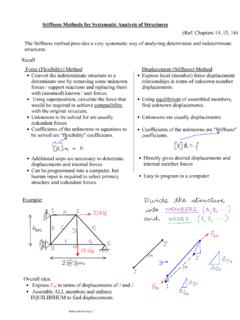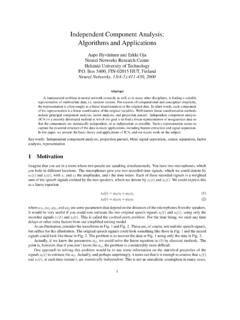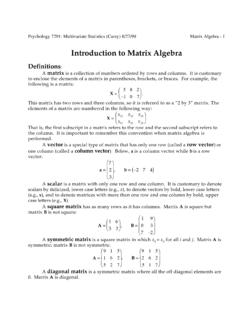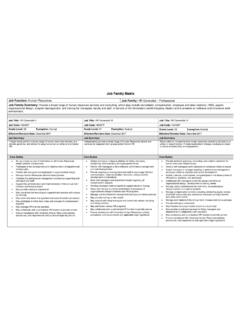Transcription of Arizona State University Qualitative Data Analysis
1 Matthew B. Miles A. Michael Huberman Johnny Salda aArizona State UniversityQualitative Data AnalysisA Methods SourcebookEdition3 Brief Table of ContentsList of Displays xiiiPreface to the Third Edition by Johnny Salda a xviiAcknowledgments From the Second Edition by Matthew B. Miles and A. Michael Huberman xxiAbout the Authors xxiiiPart One The Substantive Start ..1 Chapter 1 - Introduction 3 Chapter 2 - Research Design and Management 17 Chapter 3 - Ethical Issues in Analysis 55 Chapter 4 - Fundamentals of Qualitative Data Analysis 69 Part Two Displaying the Data ..105 Chapter 5 - Designing matrix and Network Displays 107 Chapter 6 - Methods of Exploring 121 Chapter 7 - Methods of Describing 161 Chapter 8 - Methods of Ordering 193 Chapter 9 - Methods of Explaining 221 Chapter 10 - Methods of Predicting 255 Part Three Making Good Sense ..273 Chapter 11 - Drawing and Verifying Conclusions 275 Chapter 12 - Writing About Qualitative Research 323 Chapter 13 - Closure 339 Appendix An Annotated Bibliography of Qualitative Research Resources 345 References 363 Author Index 369 Subject Index 373107 Chapter 5 | Designing matrix and Network Displays5 Designing matrix and Network DisplaysChapter SummaryThis chapter provides fundamental principles for the design and content of two analytic display methods: (1) matrices and (2) networks.
2 These methods condense the major data and findings from a study to further analyze and/or to represent and present the Format OptionsMatricesNetworksTiming of Display DesignFormatting the matrix TemplateEntering matrix and Network DataMaking Inferences and Drawing Conclusions From Matrices and NetworksThe Methods ProfilesClosure and TransitionPart II: Displaying the Data108 IntroductionLengthy, unreduced text in the form of interview transcripts, field notes, documents, and so on is cumbersome because it is dispersed over many pages and is not easy to see as a whole. It is sequential rather than simultaneous, making it difficult to look at two or three variables at once. Comparing several extended texts carefully is very difficult. It is usually poorly ordered, can get very bulky, and can make us feel monotonously overloaded. The same objections apply with even stronger force for readers of our final reports. They need, if not deserve, a concise delivery of what we analyzed.
3 And in this highly visual culture, showing rather than telling can make a more effective and memorable impact on our major purpose of this text is to encourage the creation and dissemination of matrix and network displays for Qualitative data. The central argument of this book is You know what you display. Credible and trustworthy Analysis requires, and is driven by, displays that are focused enough to permit a viewing of a full data set in the same location and are arranged systematically to answer the research questions at hand. A full data set does not, of course, mean the complete corpus of interview transcripts, field notes, documents, and so on. Rather, the condensed, distilled data presented are drawn from the full range of persons, events, and processes under study. With extended text, there can easily be selective stacking of the data. An organized display wards off this idea of display is central to this book.
4 By display we mean a visual format that presents information systematically so the user can draw conclusions and take needed action. Although such displays may sometimes be busy, they will never be monotonous. Most important, the chances of drawing and verifying conclusions are much greater than for extended text, because the display is arranged coherently to permit careful comparisons, detection of differences, noting of patterns and themes, seeing trends, and so researchers have software packages that can develop publishable tables, graphs, and charts. Qualitative researchers have CAQDAS programs for our unique approaches to data Analysis . And even basic Microsoft Office programs such as Word and Excel are sufficient for most matrix and network displays. But the Qualitative analyst has to handcraft appropriate data display formats because each project is unique. As yet, there are few familiar, agreed-on data setups among Qualitative researchers, so each analyst has to adapt those of others or invent new ones.
5 The display ideas we offer in this book are nothing more than that ideas, not prescriptions, for Qualitative data everyone loves matrices and network displays and not everyone thinks visually. But displaying your condensed data in a systematic way has immense consequences for your understanding. It requires you to think about your research questions and what portions of your data are needed to answer them; it requires you to make full analyses, ignoring no relevant information; and it focuses and organizes your information coherently. These advantages are repeated when you include displays in a final report; the reader can re-create your intellectual journey with some 5 | Designing matrix and Network DisplaysDisplay Format OptionsDeciding on and generating the format for displaying Qualitative data are important first steps. Your template is a visual outline, of sorts, for the data to be filled in. Formats can be as varied as the imagination of the analyst, but the ones described in this book tend to fall into two major families:1.
6 Matrices, with defined rows and columns2. Networks, a series of nodes with links (lines and arrows) between themData entries, however, are multiform: short blocks of text, quotes, phrases, variable labels, ratings, abbreviations, codes, categories, symbolic figures, labeled lines (dashed or solid), arrows (one way or two way), and so display format and content of the entries will depend on what you are trying to understand: a general situation, detailed chronologies, the actions of people in different roles, the interplay of variables, and so on. In other words, form follows function: Formats must always be driven by the research questions involved and your developing concepts. Formatting determines which variables will be analyzed in which ways. If a variable isn t included in the format, it won t get compared with another it depends on how far along you are in the study and what has priority right now. The need might be for eyeballing data in an exploratory way.
7 Or it could be for carrying out detailed analyses; for setting up data to use in another, more differentiated display; for combining parallel data for a single case; for combining data from several cases; or for reporting findings. A good format will allow all of these uses to some degree but inevitably will do some well and others less s examine the two major families of displays with examples and matrix is essentially the intersection of two lists, set up as rows and columns. Let s take a look at a sample format, explaining and labeling it as we , a table drawn with Microsoft Word software, is aimed at understanding the effects of assistance supplied to a school site the Masepa Case by various sources. This was part of a school improvement study that observed how a new project innovation was implemented. The matrix format calls for the researcher to address five related variables, to distinguish two of them according to time, to pool responses, to align some responses along an evaluative scale, and to explain the response pattern for each type of assistance source.
8 Here, condensed information from 30 pages of field notes has been packed into a single that the data are abstractions: There are no quotes, and generalizations and other inferential remarks appear in the last two columns. The Longer-Run Consequences and Researcher Explanations are not direct condensations of participants remarks or of researchers observations. Rather, for any given consequence, such as the one in the top row ( Users are helped administratively and substantively, feel obliged to do ECRI [Exemplary Center for Reading Instruction] with minor adaptations ), the researcher 110 Display matrix : Assistance Location and Types (Masepa Case) LocationUser s Assessment Types ProvidedShort-Run Effects (User s State )Longer-Run Consequences Researcher ExplanationsBuilding Administration++++-+1. authorizes changes2. eases schedules3. controls fidelity4. consults, offers solutions1. relieves pressure, encourages2.
9 Helps early implementation3. feeling policed4. feeling backed-up, substantially helpedusers are helped administratively and substantively, feel obliged to do ECRI with minor adaptationsadministration, authority, servicing, availability and flexibility lead to sustained, faithful implementation modelCentral Office Administration+++1. promotes ECRI2. answers building administration, trainers requests1. pressures non-users2. building administrators have material, administrative supportprogram is perceived as supported, assisted, protected by central officecentral office able to push program and answer requests, yet not perceived as main actor by usersHelping Teacher+++++++ 1. provides materials2. demonstrates, models3. answers requests4. encourages5. circulates, controls1. reduces effort, increases repertoire2. trains, facilitates use3. problems solved rapidly4. maintains level of effort5. ambivalent: helped yet coercednew, experienced users receive systematic instruction, follow-up, materials; stay with program and are careful about making changes in itpersonalized in-service mechanism, with both training and assistance allows for mastery and spread of ECRI in faithful formatUser-HelpingTeacherMeetings+++++1.
10 Comparing practices with others2. debugging, complaining3. learning about new parts4. encouragement1. encourages, regulates2. cathartic, solves short-run problems3. expands repertoire4. gets through rough momentscreates reference group, gives users a voice, solves ongoing problems and lowers anxietymulti-purpose forum which consolidates use and users, defuses oppositionTeacher-Users in Other Schools: Target Schools+++1. sharing materials2. exchanging tips, solutions3. comparing, encouraging1. increases stock2. new ideas, practices; problems solved3. motivates, stimulatesincreases commitment, regulates use (decreases deviance)additional source of assistance, which increases as number of users growsTrainers in Target School, Other School++++++1. tips for presentations2. solution to short-term problems3. encourages4. serves as successful model1. facilitates practice2. helps expand beyond core format3. maintains effort4.







